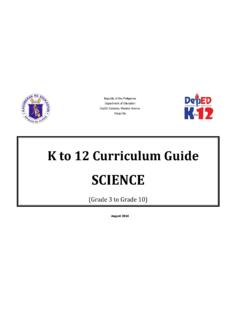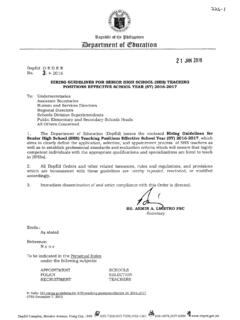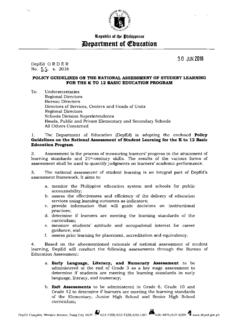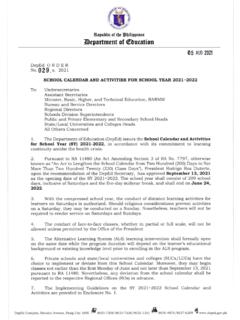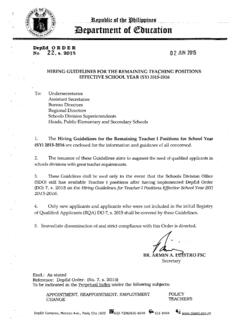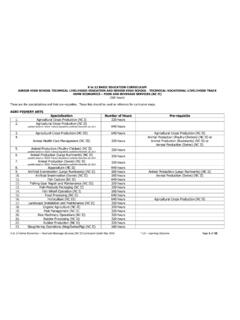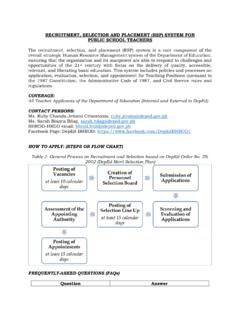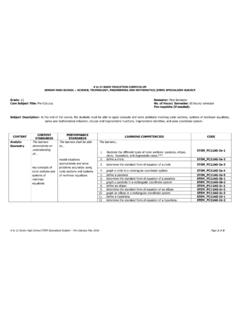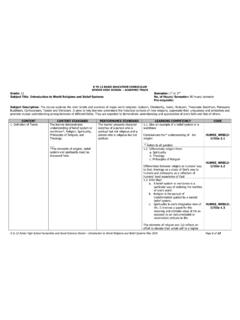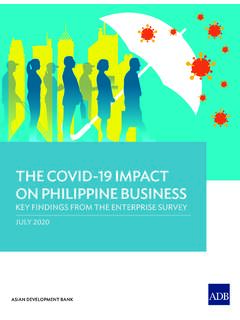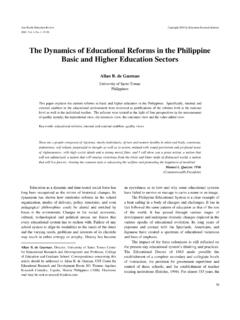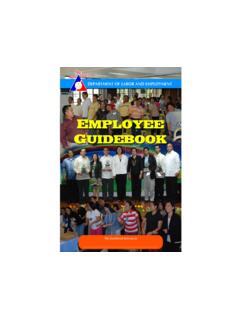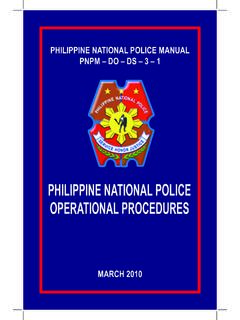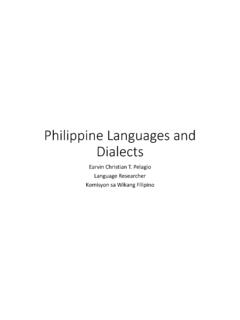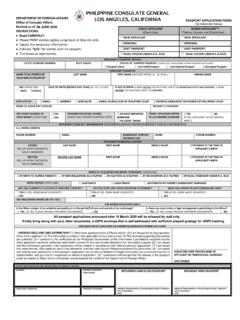Transcription of Republic of the Philippine Department of Education DepEd ...
1 Republic of the Philippine Department of Education DepEd Complex, Meralco Avenue Pasig City K TO 12 BASIC Education CURRICULUM FOR THE ALTERNATIVE LEARNING SYSTEM (ALS-K TO 12) Learning Strand 6 Digital Literacy Page 2 of 35 June 2017 LEARNING STRAND 6: DIGITAL LITERACY Twenty-first-century Philippine society is replete with myriad rapidly changing information and communication technologies (ICTs). The ways people plan, develop, implement, and communicate ideas and knowledge have been transformed as computers, the internet, social media, and mobile devices have become increasingly pervasive. To adapt to these changes, Filipinos need to develop a whole new range of ICT-related skills to be effective citizens in an increasingly digital world.
2 This Learning Strand addresses the needs of ALS learners to develop basic skills in ICT use and digital literacy. Accordingly, a new Learning Strand has been added to the ALS Curriculum focused on Digital Literacy for 21st-century Filipino citizens. This Learning Strand seeks to help equip ALS learners with critical knowledge, skills, and values to be able to live and work effectively as part of the digital universe. Below is the schematic diagram for this new Learning Strand: K TO 12 BASIC Education CURRICULUM FOR THE ALTERNATIVE LEARNING SYSTEM (ALS-K TO 12) Learning Strand 6 Digital Literacy Page 3 of 35 June 2017 The schematic diagram shows that the overall goal of this Learning Strand is to produce 21st-century digital citizens who are confident in using ICT and digital tools in a responsible and ethical manner.
3 Digital literacy is needed to achieve this goal. Digital literacy is the capacity of every ALS learner to safely and responsibly generate, apply, and share digital information in multiple formats from a wide range of sources using computers or mobile devices. To achieve digital literacy, ALS learners need both ICT-related knowledge and skills, and the ability to integrate such skills and knowledge across the competencies listed in the other four Learning Strands of the ALS curriculum. This is the application part where the learners utilize their digital knowledge and skills as tools to communicate with others and solve problems in daily life. Each of the other four Learning Strands will thus go hand in hand with Learning Strand 5.
4 This Learning Strand covers the following digital literacy competencies: Content Standard Performance Standard Digital Concepts Explain basic concepts related to use of information communication technologies (ICTs) in an increasingly digital world Digital Operations and Management Demonstrate knowledge of basic hardware operations, software operations, and file management in using a computer. Digital Applications Use common office application software packages (word processing, spreadsheet, presentation software) to produce documents and manage information as tools to solve problems in daily life. Digital System Network Navigate the digital global system to search for information and resources and communicate with others in everyday life.
5 Digital Devices Make use of mobile devices as tools to access information and communicate with others. Digital Ethics Demonstrate ethical practices and values in using technology in the 21st century. The learning competencies and skills in this Learning Strand are sequenced from the simplest to the most complex and based on the content standards. Leveling of the learning competencies will start at Lower Elementary up to Advanced Secondary. K TO 12 BASIC Education CURRICULUM FOR THE ALTERNATIVE LEARNING SYSTEM (ALS-K TO 12) Learning Strand 6 Digital Literacy Page 4 of 35 June 2017 Here is a sample of digital literacy Integration across the competencies of other Learning Strands Example 1: LS 1 (Speaking): PSB 32.
6 Make and prepare for an oral presentation. LS 5: PSA 2. Compare the experiences of people using technology in the 21st century to those who lived in the 20 h century. Example 2: LS 4: PSA Cite examples of situations or occasions in which self-discipline could or should be practiced. LS 5: PSF 3. Practice respectful conduct when using the internet. Sensitivity to national and local cultures Avoiding identity misrepresentation and fraud Internet etiquette while chatting, emailing, blogging, and using social media Example 3: LS 2 (Scientific Thinking): PSB Make a simple project proposal to address one prevalent problem. LS 5: PSC (Word Processing) Make use of formatting in paragraphs.
7 Create and/or merge paragraph(s) Practice in aligning text: use align, indent as tools Alignment of text: left, center, right, justified Indent paragraphs: left, right, first line Apply spacing: between paragraphs, above, below, single, lines, double line Note: ICT integration goes beyond merely using computer hardware and software as communication and information management tools. It also includes empowering ALS learners to explore the potentials offered by mobile devices, social media, and other digital media in order to navigate the digital world. This journey as 21st-century digital citizens requires such learners to be practicing sound digital ethics and values so that ICT and other digital tools are used responsibly and safely amid rapid technological changes.
8 This includes guarding against potential risks and threats found in the digital world, and maximizing the opportunities and potentials of ICT and other digital technologies as tools for personal and professional development and improving one s quality of life as a 21st-century digital citizen. SENIOR HIGH SCHOOL To complete SHS and meet the competencies for the middle skills development, entrepreneurship, and employment exits of the basic Education curriculum, ALS learners must complete the competencies that are specified Empowerment Technologies (which is an applied subject). They should also complete the specialization subjects of any of the following Senior High School tracks: Sports, Arts and Design or Technical-Vocational-Livelihood.
9 K TO 12 BASIC Education CURRICULUM FOR THE ALTERNATIVE LEARNING SYSTEM (ALS-K TO 12) Learning Strand 6 Digital Literacy Page 5 of 35 June 2017 College-bound ALS learners in SHS must also complete the core subject Media and Information Literacy (or its equivalent). They must also complete all the specialization subjects in any of the Academic Strands (Accountancy, Business and Management [ABM], Humanities and Social Sciences [HUMSS], Science, Technology, Engineering and Mathematics [STEM], or General Academic). If an ALS learner who has completed the K to 12 curriculum wishes to proceed to higher Education , this learner may return to the ALS program and take the core curriculum at any time.
10 K TO 12 BASIC Education CURRICULUM FOR THE ALTERNATIVE LEARNING SYSTEM (ALS-K TO 12) Learning Strand 6 Digital Literacy Page 5 of 35 June 2017 Learning Strand 6: Digital Literacy Content Standard: Digital Concepts Performance Standard A: Explain basic concepts related to the use of information communication technologies (ICTs) in an increasingly digital world. No. Learning Competency Code Basic Level Elementary Level Secondary Level K to 12 ALS Lower Advanced Junior High School Senior High School 1 Define what is meant by information and communications technology (ICTs) using examples from everyday life LS6DL-DC-PSA-BL/LE/AE/LS/AS-1 2 Compare the experiences of people using technology in the 21st century to those who lived in the 20th century LS6DL-DC-PSA-BL/LE/AE/LS/AS-2 characteristics of technologies used advantages and disadvantages 3 Explain the key differences between so-called digital natives and digital migrants LS6DL-DC-PSA-LE/AE/LS/AS-3 4 Give examples from daily life of the advantages and disadvantages of the 21st century in terms of ICT LS6DL-DC-PSA-BL/LE/AE/LS/AS-4 5 Describe the computer and its characteristics LS6DL-DC-PSA-LE/AE/LS/AS-5 6 Identify the different types of computer
